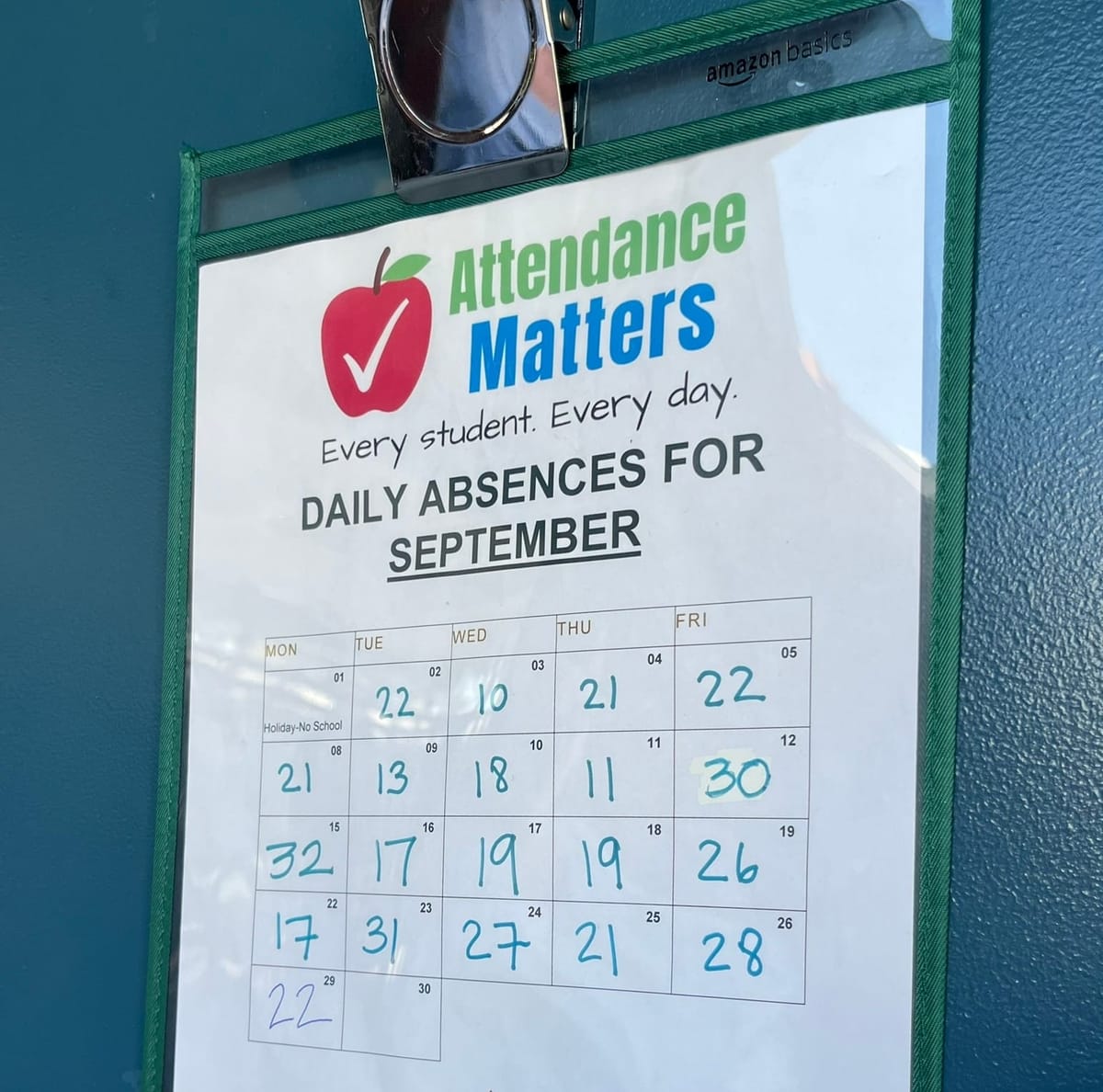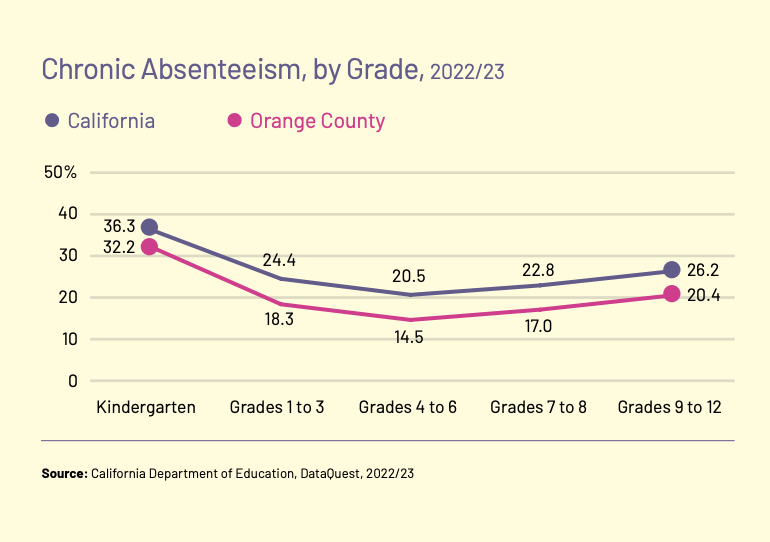What Happens When Students Don’t Show Up to School?
O.C. districts use Attendance Awareness Month to remind families that absences can impact learning and funding.

This month, two campuses in the Brea-Olinda Unified School District were locked in a friendly, but important, competition.
“The Arovista (Elementary) ALLSTARS are calling out the Laurel (Elementary) Leopards for an epic Attendance Challenge!,” proclaimed an August 29 Instagram post featuring Arovista Principal Eric Barrientos. Laurel students, led by Principal Erika Lopez, responded “It’s on!!!” in a stylishly edited video set to the T.I. song “Bring Em Out.”
What was the mission for students in this four-week challenge? Show up to school every day and on time to achieve an attendance rate of 98% for the month. The prize? The losing principal would be forced to wear the other school’s gear and colors.

At Brookhurst Elementary School in the Garden Grove Unified School District, students and staff participated in dress up days, including pajama day, to get kids excited about coming to campus. “The celebration reinforced teamwork, school pride, and the importance of building strong attendance habits that set the foundation for lifelong success,” read a post from the district.
These are two examples of how local schools and districts marked Attendance Awareness Month, a nationwide campaign to educate families about the importance of students being at school.
Attendance is crucial for students and public schools for numerous reasons. First and foremost, missing school could put students at risk of falling behind in their learning, especially in younger grades. “Early absences correlate with reading difficulties and poor attendance patterns in later years,” according to a 2014 report from Attendance Works.
In Orange County, kindergartners had the highest rate of chronic absenteeism among all grade levels, according to the most recent Report on the Conditions of Children in Orange County. A student is labeled chronically absent if they miss 10% or more of the school year, about two days a month. For the 2022-23 school year, 32.2% of all kindergartners were deemed chronically absent.

Absenteeism can also limit a student’s ability to form meaningful relationships with fellow students and teachers. “While academic achievement is one clear outcome of consistent attendance, the benefits go beyond grades and test scores,” reads a Sept. 9 message from the Irvine Unified School District. “Daily attendance supports the development of friendships, collaboration and a sense of belonging within the school community. These skills are critical for preparing students to become engaged, well-rounded citizens,” it continued.
Last, but not least, since California schools are funded based on how many students show up, lower attendance rates means less money for schools. California pays districts based on Average Daily Attendance or ADA. ADA is defined as “the total days of student attendance divided by the total days of instruction,” according to the California Department of Education.
As part of its “Attending School is Cool” campaign for Attendance Awareness Month, the Los Alamitos Unified School District sent a letter to families outlining the reasons why showing up to school matters. In addition to sharing how missing class can negatively impact a student’s academic performance and sense of belonging, the letter also stressed that absenteeism can have a significant financial impact.
When one student misses one day of school, it amounts to a loss of around $66, according to the district. And that can add up. For example, in the 2024-25 school year, Los Alamitos Unified’s ADA was 95.77% netting $99.1 million in state funding. A 100% attendance rate would mean up to an estimated $4 million more.
How attendance rates impact the Los Alamitos Unified School District's finances was discussed at the Sept. 9 meeting of the Los Alamitos USD Board of Education.
“Before Covid, our attendance rates were close to 97%,” Superintendent Andrew Pulver, Ed.D., said during the Los Alamitos Unified School District Board of Education meeting on Sept. 9. “Lately they've been hovering in the 95.5, 95.6, 95.7 (range). And just a 1% increase in our attendance would garner a million dollars more in funding to provide support for students … increased staffing and programs and services.”
Another important note is that high rates of absenteeism limit the types of recognition or awards a campus can receive including being named a California Distinguished School. ADA is also based on an average of three years of attendance data so one year with low attendance could impact future funding.
Attendance Recovery Options
The school year in California is typically 180 days long. The reasons students miss class can vary. It could be a transportation issue, or it could be a health issue. Officials ask families to schedule medical and dental appointments outside of regular school hours.
Sometimes it's sports or extracurricular activities that pull students out of the classroom. For others, it’s a family vacation taken outside of regular school breaks. Schools do have options to recover funding and provide opportunities for students to make up missed lessons.
For instance, Dr. Pulver said students and families could consider using short-term independent study. This allows for students that are missing a minimum of three days of school to complete academic work while they are out of town. Independent study requires advance notice to the teacher and a written contract. Students must complete the work and turn it in upon return to earn credit and for the school to receive funding.
Some districts are utilizing a new option from the California Department of Education for students to make up missed instructional time and for schools to recover funding tied to ADA. Starting in the 2025-26 fiscal year, school districts, county offices of education and classroom-based charter schools can offer an Attendance Recovery program. The program can be held before or after school, on weekends, or even during breaks. Students "must be engaged in educational activities and content aligned to grade-level standards that are substantially equivalent to the student’s regular instructional program, which may include one-on-one or small group tutoring," according to the CDE.
For example, Richman Elementary School in the Fullerton School District recently hosted its first Saturday School Opportunity Attendance Recovery (SSOAR). In the past, the Westminster School District offered a Saturday Academy for students to make up absences.
Back in the Brea-Olinda USD, the Attendance Challenge wrapped up this week with smiles from both schools' leaders. At the start of the final week of competition, Barrientos paid a visit to Lopez to make sure she was wearing Arovista gear after the Allstars won the first three weeks of the competition.
"I'm representing two amazing schools that have improved attendance tremendously, Arovista and Laurel Leopards," Lopez said with a smile and a tug at her Arovista t-shirt.
But in the final week, Laurel came back to score a victory. Barrientos had to wear a Laurel Leopards shirt. In a post from Sept. 30, he praised all Arovista and Laurel students for showing up and taking part in the competition. "This friendly challenge made us ALL better and kept the focus where it matters most: being present, learning, and growing every day," the post read.
Barrientos encouraged students to keep it up. "That 98% challenge isn't just for September, it is for the entire year, because when you're here, you belong."
